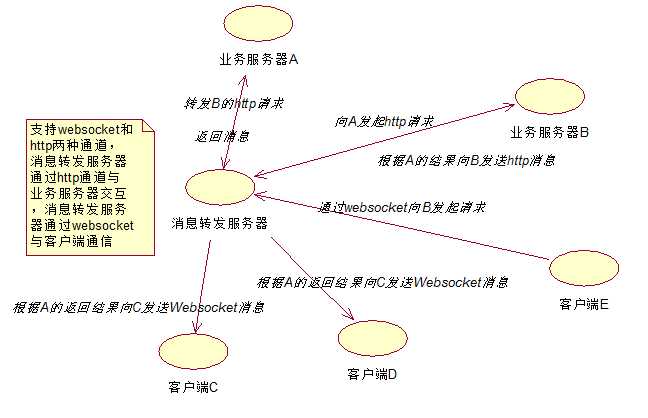标签:
1、结构图

2、消息服务器
消息服务器(SNS)由Http Netty Server(HNS)和WebSocket Netty Server(WNS)组成。HNS采用Netty Http+XML协议栈开发实现,WNS采用Netty WebSocket+JSON实现。
HNS只接收预定义的HttpXmlRequest类型的数据,这由编解码器控制,编解码器是继承了MessageToMessageDecoder<T>和MessageToMessageEncoder<T>这两个编解码基础类、并用于解析处理预定义HttpXmlRequest数据的类。HNS根据接收结果向客户端发送预定义的HttpXmlResponse类型数据。
HNS可以通过HttpXmlClient创建与业务服务器的链接,并通过HttpXmlClientHandler转发业务请求。HttpXmlClientHandler继承自SimpleChannelInboundHandler,通过它可以实现HNS与业务服务器的异步通信。
目前,WNS主要用于与Web客户端端进行websocket通信,WNS通过全局变量Global.WSCG维护通道信息,通过Global.appUsers维护客户端连接。WNS定义了一个消息基类BaseMsg,该类描述了客户端发起请求所需要的数据信息。同样,WNS也定义了一个AppUser类用于存储客户端信息,必须说明的一点是,同一个AppUser可能存在多个通道,因此,在AppUser中定义了一个ChannelId数组,该数组维护了当前用户的所有通道ID。客户端发起连接请求时,必要的数据包括appid、userId、cmd,appid是一个业务服务器的唯一标识。
3、业务服务器
业务服务器是各个应用端建立的与SNS交互的Http Netty Server,换句话说,每一个应用都需要启动一个HNS用于与SNS交互。同样的,业务服务器也是通过HttpXmlClient向SNS的HNS发起连接请求,不再赘述。
4、HttpXmlServer
package com.sns.protocol.http.xml.server;
import java.net.InetSocketAddress;
import com.zehin.sns.protocol.http.xml.codec.HttpXmlRequest;
import com.zehin.sns.protocol.http.xml.codec.HttpXmlRequestDecoder;
import com.zehin.sns.protocol.http.xml.codec.HttpXmlResponseEncoder;
import com.zehin.sns.protocol.http.xml.pojo.HttpRequestMessage;
import io.netty.bootstrap.ServerBootstrap;
import io.netty.channel.AdaptiveRecvByteBufAllocator;
import io.netty.channel.ChannelFuture;
import io.netty.channel.ChannelInitializer;
import io.netty.channel.ChannelOption;
import io.netty.channel.EventLoopGroup;
import io.netty.channel.SimpleChannelInboundHandler;
import io.netty.channel.nio.NioEventLoopGroup;
import io.netty.channel.socket.SocketChannel;
import io.netty.channel.socket.nio.NioServerSocketChannel;
import io.netty.handler.codec.http.HttpObjectAggregator;
import io.netty.handler.codec.http.HttpRequestDecoder;
import io.netty.handler.codec.http.HttpResponseEncoder;
public class HttpXmlServer implements Runnable {
private EventLoopGroup bossGroup = null;
private EventLoopGroup workerGroup = null;
private SimpleChannelInboundHandler<HttpXmlRequest> handler = null;
private int port = 9999;
@SuppressWarnings("unused")
private HttpXmlServer() {
}
public HttpXmlServer(int _port, SimpleChannelInboundHandler<HttpXmlRequest> _handler) {
this.port = _port;
this.handler = _handler;
}
@Override
public void run() {
// 处理网络连接---接受请求
bossGroup = new NioEventLoopGroup();
// 进行socketChannel的网络读写
workerGroup = new NioEventLoopGroup();
try {
ServerBootstrap b = new ServerBootstrap();
b.group(bossGroup, workerGroup).channel(NioServerSocketChannel.class)
// boss线程接收参数设置,BACKLOG用于构造服务端套接字ServerSocket对象,
// 标识当服务器请求处理线程全满时,用于临时存放已完成三次握手的请求的队列的最大长度。
// 如果未设置或所设置的值小于1,Java将使用默认值50。
.option(ChannelOption.SO_BACKLOG, 1024)
// 发送缓冲器
.option(ChannelOption.SO_SNDBUF, 1024)
// 接收缓冲器
.option(ChannelOption.SO_RCVBUF, 1024)
// 接收缓冲分配器
.option(ChannelOption.RCVBUF_ALLOCATOR, new AdaptiveRecvByteBufAllocator(256, 2048, 65536))
// work线程参数设置
.childOption(ChannelOption.RCVBUF_ALLOCATOR, new AdaptiveRecvByteBufAllocator(256, 2048, 65536))
.childHandler(new ChannelInitializer<SocketChannel>() {
@Override
protected void initChannel(SocketChannel ch) throws Exception {
ch.pipeline().addLast("http-decoder", new HttpRequestDecoder());
ch.pipeline().addLast("http-aggregator", new HttpObjectAggregator(65536));
ch.pipeline().addLast("xml-decoder",
new HttpXmlRequestDecoder(HttpRequestMessage.class, true));
ch.pipeline().addLast("http-encoder", new HttpResponseEncoder());
ch.pipeline().addLast("xml-encoder", new HttpXmlResponseEncoder());
ch.pipeline().addLast("xmlServerHandler", handler);
}
});
ChannelFuture future = b.bind(new InetSocketAddress(port)).sync();
System.out.println("HTTP netty server started. the port is " + port);
future.channel().closeFuture().sync();
} catch (Exception e) {
e.printStackTrace();
} finally {
bossGroup.shutdownGracefully();
workerGroup.shutdownGracefully();
}
}
public void shutdown() {
if (bossGroup != null)
bossGroup.shutdownGracefully();
if (workerGroup != null)
workerGroup.shutdownGracefully();
}
}
5、HttpXmlServerHandler
package com.sns.protocol.http.xml.server;
import static io.netty.handler.codec.http.HttpHeaders.isKeepAlive;
import static io.netty.handler.codec.http.HttpHeaders.Names.CONTENT_TYPE;
import static io.netty.handler.codec.http.HttpResponseStatus.INTERNAL_SERVER_ERROR;
import static io.netty.handler.codec.http.HttpVersion.HTTP_1_1;
import com.zehin.sns.protocol.http.xml.codec.HttpXmlRequest;
import com.zehin.sns.protocol.http.xml.codec.HttpXmlResponse;
import com.zehin.sns.protocol.http.xml.pojo.HttpRequestMessage;
import com.zehin.sns.protocol.http.xml.pojo.HttpResponseMessage;
import io.netty.buffer.Unpooled;
import io.netty.channel.ChannelFuture;
import io.netty.channel.ChannelFutureListener;
import io.netty.channel.ChannelHandler.Sharable;
import io.netty.channel.ChannelHandlerContext;
import io.netty.channel.SimpleChannelInboundHandler;
import io.netty.handler.codec.http.DefaultFullHttpResponse;
import io.netty.handler.codec.http.FullHttpResponse;
import io.netty.handler.codec.http.HttpRequest;
import io.netty.handler.codec.http.HttpResponseStatus;
import io.netty.util.CharsetUtil;
import io.netty.util.concurrent.Future;
import io.netty.util.concurrent.GenericFutureListener;
@Sharable
public final class HttpXmlServerHandler extends SimpleChannelInboundHandler<HttpXmlRequest> {
@Override
public void messageReceived(final ChannelHandlerContext ctx, HttpXmlRequest xmlRequest) throws Exception {
HttpRequest request = xmlRequest.getRequest();
HttpRequestMessage reqMessage = (HttpRequestMessage) xmlRequest.getBody();
System.out.println("Http server receive request : " + reqMessage);
HttpResponseMessage resMessage = dobusiness(reqMessage);
ChannelFuture future = ctx.writeAndFlush(new HttpXmlResponse(null, resMessage));
if (!isKeepAlive(request)) {
future.addListener(new GenericFutureListener<Future<? super Void>>() {
public void operationComplete(Future future) throws Exception {
ctx.close();
}
});
}
}
private HttpResponseMessage dobusiness(HttpRequestMessage req) {
HttpResponseMessage resMessage = new HttpResponseMessage();
if (req.getCmd() == 0) {
resMessage.setResult(true);
} else {
// other verify code here...
}
return resMessage;
}
@Override
public void exceptionCaught(ChannelHandlerContext ctx, Throwable cause) throws Exception {
cause.printStackTrace();
if (ctx.channel().isActive()) {
sendError(ctx, INTERNAL_SERVER_ERROR);
}
}
private static void sendError(ChannelHandlerContext ctx, HttpResponseStatus status) {
FullHttpResponse response = new DefaultFullHttpResponse(HTTP_1_1, status,
Unpooled.copiedBuffer("失败: " + status.toString() + "\r\n", CharsetUtil.UTF_8));
response.headers().set(CONTENT_TYPE, "text/plain; charset=UTF-8");
ctx.writeAndFlush(response).addListener(ChannelFutureListener.CLOSE);
}
}
6、备注
主要参考《Netty权威指南》而写了个简单的消息转发。
标签:
原文地址:http://www.cnblogs.com/sdnu/p/5946498.html